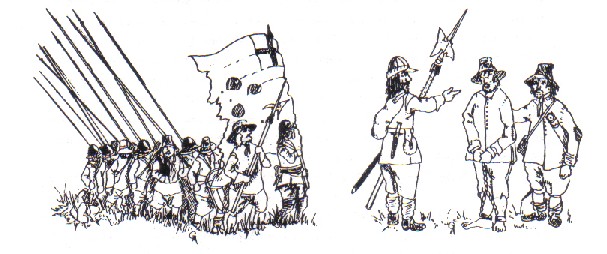Within the pages of this journal the merits of the London Trained Bands have been, in the past, sung loudly. Now it is the time to highlight the exploits of the Militia of Staffordshire whom, if not the Londoners match on the Field, more than made up for it with apathy and an ability to Riot!
The Staffordshire Trayned Bands date back to the Tudor re-organisation, as with other Trained Bands. The official strength was set at 400 Foot and 100 Horse. These were raised within the Hundreds of Staffordshire - Totmonslow Hundred (in the North East, including Uttoxeter), Pirehill Hundred (the North West including Stoke and Stafford), Cuttlestone Hundred (the West and Centre, including Gnosall), Offlow Hundred (the South and East, including Lichfield and West Bromwich) and Seisden Hundred (the South West including Wolverhampton). "The twoe greate hundreds of Pirehall and Offlowe to finde the one halfe of them, and the three small Hundreds the other". The composition of the Trained Bands was, in the 1642 remodelling at least, drawn from the different social levels, "the said horse shall be found from the gentlemen and the foot by the freholders, coppieholders and persons of abillitie of the said county".
Like so many of their brethren in other Counties, the men of Staffordshire were not wholly taken with the idea of serious military practice, and little record exists of their peacetime activities. In 1639, the month of July saw a mustering of these heroes at Uttoxeter. It was here they showed how fierce they could be in riot. The King's Agent, busy in the search to raise money, had enclosed the lands around the 'high Wood', an area the locals used to graze cattle. This was not popular with the locals and, led by a drummer, some soldiers (mostly Pikemen) of the Militia marched forth and gallantly pulled down the fences and burnt them.
In 1640, 300 of the Militia were raised to take part in the Bishop's War. The Muster was again to take place at Uttoxeter. The War was not popular and the troops were mutinous. 100 men were mustered from the Seisden and Cuttlestone Hundreds. The Deputy Lieutenants, Sir Hervey Bagot, Walter Wrottesley and Thomas Compton, were in charge of the Mustering. They ordered the constables to "guard them until the King's Officers have taken care of them, and the constable of Uttoxeter to have ready sufficient men well armed to speedily put down all tumults that might ariss in the town". At 11 o'clock the soldiers made a break from Uttoxeter to burn down the High Wood fences again. They were pursued by Mr Warner, constable of Uttoxeter, with 100 men armed with Halbers and bills. Little was done to stop the rioters (as Warner did not wish to shed blood) and the constable's only action was to set a guard on the town to prevent others joining in the fun. The next morning the troops again broke out and did even more damage !! On July 3rd, two days after the Trained bands first "action", Bagot had raised all the armed men from within five miles of the town, to guard the "King's Army", keeping them in good order until the King's officers collected them. 17 rioters were taken for trial.
When the Civil War came, it was not greeted with great enthusiasm by the men of Staffordshire. The King wrote from Nottingham in September, to the High Sherrif. He desired "to marche all ye gentlemen with the trayned bandes of that county...to guard our passage throughout the said county". When Charles reached Uttoxeter, on his way to Edgehill, he was met only by a few Knights and gentlemen, "in warlike posture" who came to see the King in order to petition him to seek a peaceful end to the War. The Trained Bands had not mustered, but Rupert set about gathering those of Uttoxeter to protect the march to Stafford, by threatening to burn down the houses of those who would not. It is likely that those Staffordshire men who wished to fight for the King would have joined Sir John Beaumont's or Lord Paget's Regiments.
With the excitement over, apathy once more took its rightful place, the War being imported by Brereton, Gell, Northampton and Rupert. In November, the King wrote to High SHerrif William Cumberford requesting he raised forces for the defence of the county. The Quarter session re-modelled the Trained Bands for this purpose. The structure remained the same but numbers were doubled to 800 Foot and 200 Horse. New Captains were also appointed.
